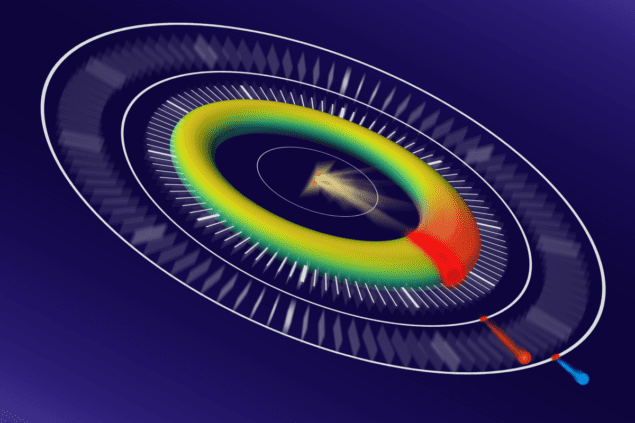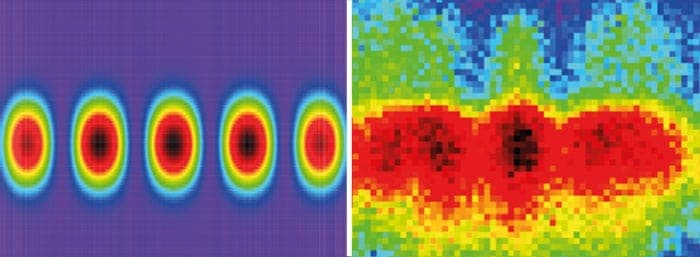
The decay lifetime associated with the emission of Auger electrons from atoms has been measured to sub-femtosecond precision using a technique called self-referencing attosecond streaking. Daniel Haynes of the Max Planck Institute for the Structure and Dynamics of Matter in Hamburg and an international team of scientists are the first to make such a measurement using an X-ray free electron laser (XFEL). They found that the Auger decay lifetime is significantly longer than that predicted by a semi-classical approximation, but in agreement with a fully quantum calculation. The team says that their new technique could soon be used to study the quantum entanglement of electrons in molecules.
Since its invention in the early 2000s, attosecond streaking has illuminated atomic and molecular dynamics on unimaginably short timescales. In conventional attosecond streaking spectroscopy, an initial laser pulse triggers the ionization of an atom or molecule before the oscillating electric field of a second, longer-wavelength laser pulse modulates the energy of the emitted electrons. Some electrons will gain a boost in energy from the modulation, while others will lose energy. This streaking is measured and can be used to work out properties of the emitted electrons.
The temporal stability of the pulses is crucial, according to team member Adrian Cavalieri of the Paul Scherrer Institute in Switzerland: “One of the big enablers for attosecond spectroscopy in the laboratory was the phase stability of the field…So you can very carefully change the delay between your laser field and your ionization event and use the ramp of the laser field to get whatever information you want.”
Timing jitter
XFELs are large, accelerator-based radiation sources that deliver high-energy, laser-like pulses of radiation. However, they suffer from an unavoidable problem called timing jitter – an inconsistency in the gaps between successive pulses.
“There is a physical element in that the X-ray [laser] pulses are produced by self-amplified spontaneous emission, which is slightly stochastic, so you can’t predict with 100% accuracy and infinite precision when the pulse will be produced,” explains Haynes.
This had made XFELs unsuitable for delivering ionization pulses for attosecond streaking and prevented researchers from studying many important high-energy atomic processes such as Auger decay with sub-femtosecond resolution.
Ejected electrons
The Auger process begins when high-energy radiation such as X-rays eject an electron (called a photoelectron) from an inner orbital in an atom. This creates a core-hole, which is immediately filled by an electron from an outer orbital. This leaves the atom with extra energy, which is removed by the emission of a second (Auger) electron. Studying this extremely common effect is key to understanding many important processes in atomic physics.
Characterizing the Auger process on the appropriate timescale requires ultrashort, intense X-ray pulses that are beyond the capability of small-scale X-ray lasers. XFELs can deliver appropriate femtosecond pulses, but their timing jitter is about 100 times longer than the timescale of Auger decay.
In their new work, the team found a clever way to get around this problem. They could not control the timing of the X-ray pulses, they reasoned, therefore they could not control the phase of the streak field at the time the photoelectron was emitted. They did know, however, that this phase would evolve in the time between the emission of the photoelectron and the emission of the Auger electron. The streak field would therefore imprint a different phase on the two electrons, and this would be reflected in their relative energies.
Clear elliptical pattern
The researchers made 80,000 measurements at the Linac Coherent Light Source, an XFEL at SLAC in California. They plotted detected photoionization energies against the Auger electron energies. This showed a clear elliptical pattern, which the researchers then used to reconstruct the phase delays – and from that the time delays – between the two electrons. Their results showed an Auger decay lifetime of 2.2 fs. This is longer than predicted by a classical approximation, which treats the two emission processes separately. Instead, the measurement agrees with a fully quantum model of the correlated electron decay.

SOLEIL scientists create double-slit thought experiment
David Villeneuve of the Joint Attosecond Science Laboratory in Canada is impressed by the research: “XFELs have very poor timing jitter, making accurate time measurements unfeasible. The work by Haynes [and colleagues] has solved this problem,” he says. “This self-referencing technique greatly expands the range of experiments that can be done at XFEL facilities. It requires that there are two electrons emitted so that their relative timing can be measured but opens up new possibilities for experiments that benefit from the huge light intensities available from XFEL sources.”
Reinhard Dörner of Goethe University in Frankfurt agrees: “This is wonderful work, which really pushes the limits of time resolution achievable with FELs. It also paves the way towards time-resolved views of entanglement of electrons in molecules for the future.”
The research is described in Nature Physics.
